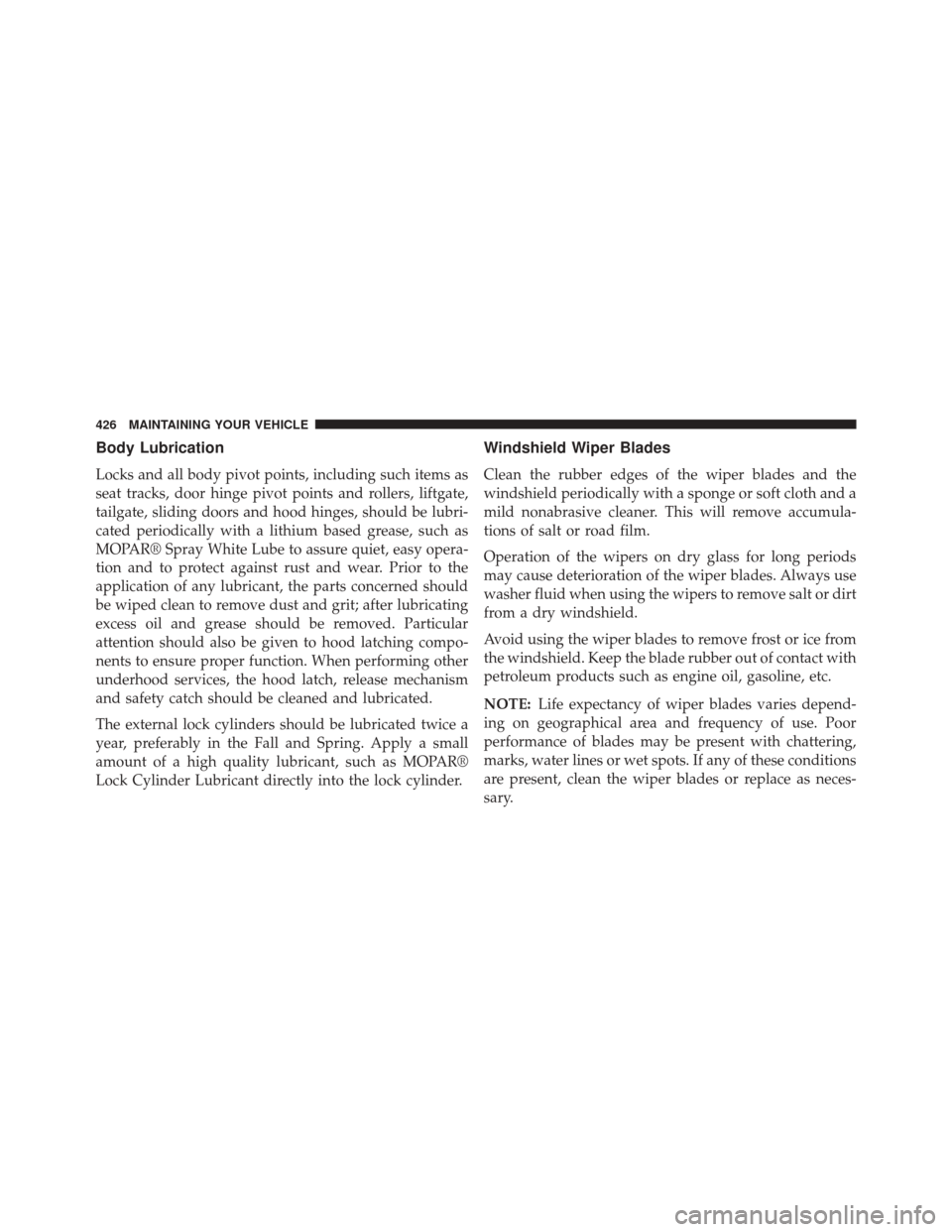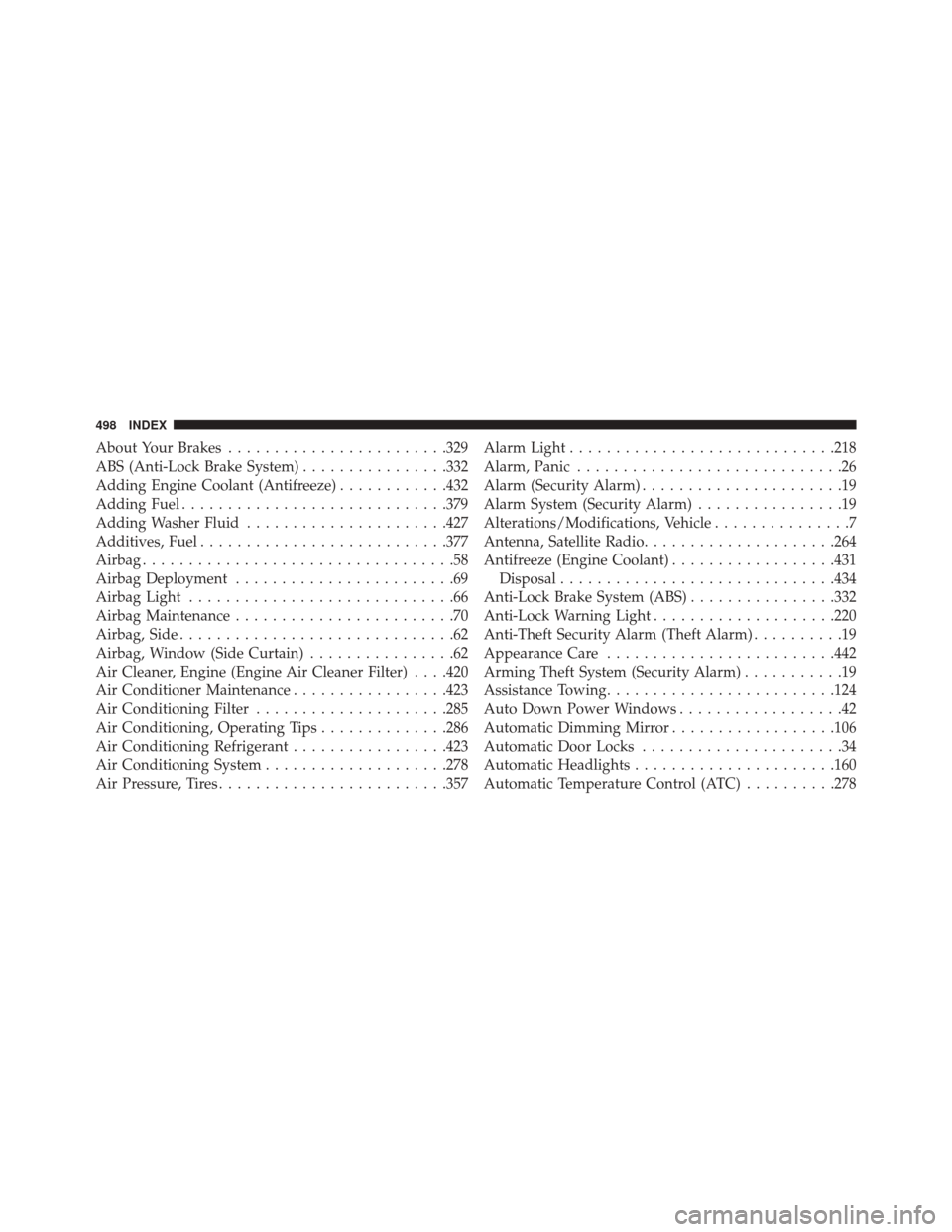Page 169 of 520

CAUTION!
Turn the windshield wipers off when driving
through an automatic car wash. Damage to the wind-
shield wipers may result if the wiper switch is left in
any position other than off.
Intermittent Wiper System
Use the intermittent wiper when weather conditions
make a single wiping cycle with a variable pause be-
tween cycles desirable. Rotate the end of the multifunc-
tion lever to the first detent position, and then turn the
end of the lever to select the desired delay interval. There
are four delay settings, which allow you to regulate the
wipe interval from a minimum of one cycle every second
to a maximum of approximately 36 seconds between
cycles. The delay intervals will double in duration when
the vehicle speed is 10 mph (16 km/h) or less.
Mist Feature
Rotate the end of the lever downward to the Mist
position to activate a single wipe cycle to clear off road
mist or spray from a passing vehicle. The wipers will
continue to operate until you release the multifunction
lever.
NOTE:The mist feature does not activate the washer
pump; therefore, no washer fluid will be sprayed on the
windshield. The wash function must be used in order to
spray the windshield with washer fluid.
Windshield Washers
To use the washer, push the multifunction lever inward
(toward the steering column) and hold it for as long as
washer spray is desired.
If you activate the washer while the windshield wiper
control is in the delay range, the wipers will operate for
3
UNDERSTANDING THE FEATURES OF YOUR VEHICLE 167
Page 226 of 520
•Door(s) Ajar (with a single chime if vehicle is in
motion)
• Trunk Ajar (with a single chime)
• Oil Change Required
• Low Washer Fluid (with a single chime)
• Channel # Transmit
• Channel # Training
• Channel # Trained
• Clearing Channels
• Channels Cleared
• Did Not Train
• Low Tire Pressure (with a single chime)
• Service TPM System (with a single chime) •
Tire Pressure Display Screen With Low Tire(s) “Inflate
Tire to XX”
• ESC Off – Electronic Stability Control is deactivated
• Check Gascap
• Key Fob Battery Low
• Service Keyless System
• Wrong Key
• Damaged Key
• Key not Programmed
• Push Button or Insert Key/Turn To Run (refer to
“Remote Starting System” in “Things To Know Before
Starting Your Vehicle”)
• 1–4 SKIPSHIFT
• UPSHIFT
224 UNDERSTANDING YOUR INSTRUMENT PANEL
Page 413 of 520
MAINTAINING YOUR VEHICLE
CONTENTS
�ENGINE COMPARTMENT — 6.4L (392 HEMI) . .413
�ONBOARD DIAGNOSTIC SYSTEM — OBD II . .414
▫ Loose Fuel Filler Cap ..................414
� EMISSIONS INSPECTION AND MAINTENANCE
PROGRAMS ......................... .415
� REPLACEMENT PARTS ..................416
� DEALER SERVICE ..................... .416
� MAINTENANCE PROCEDURES ...........417
▫ Engine Oil ......................... .418
▫ Engine Oil Filter ..................... .420▫
Engine Air Cleaner Filter ................420
▫ Maintenance-Free Battery ...............421
▫ Air Conditioner Maintenance .............423
▫ Body Lubrication .....................426
▫ Windshield Wiper Blades ...............426
▫ Adding Washer Fluid ..................427
▫ Exhaust System ..................... .427
▫ Cooling System ..................... .430
▫ Brake System ....................... .436
▫ Clutch Hydraulic System (Manual Transmission) –
If Equipped ......................... .438
7
Page 415 of 520
ENGINE COMPARTMENT — 6.4L (392 HEMI)
1 — Remote Jump Start (Positive Battery Post)6 — Air Cleaner Filter
2 — Engine Oil Dipstick 7 — Power Steering Fluid Reservoir
3 — Engine Oil Fill 8 — Integrated Power Module (Fuses)
4 — Brake Fluid Reservoir 9 — Washer Fluid Reservoir
5 — Engine Coolant Reservoir
7
MAINTAINING YOUR VEHICLE 413
Page 428 of 520

Body Lubrication
Locks and all body pivot points, including such items as
seat tracks, door hinge pivot points and rollers, liftgate,
tailgate, sliding doors and hood hinges, should be lubri-
cated periodically with a lithium based grease, such as
MOPAR® Spray White Lube to assure quiet, easy opera-
tion and to protect against rust and wear. Prior to the
application of any lubricant, the parts concerned should
be wiped clean to remove dust and grit; after lubricating
excess oil and grease should be removed. Particular
attention should also be given to hood latching compo-
nents to ensure proper function. When performing other
underhood services, the hood latch, release mechanism
and safety catch should be cleaned and lubricated.
The external lock cylinders should be lubricated twice a
year, preferably in the Fall and Spring. Apply a small
amount of a high quality lubricant, such as MOPAR®
Lock Cylinder Lubricant directly into the lock cylinder.
Windshield Wiper Blades
Clean the rubber edges of the wiper blades and the
windshield periodically with a sponge or soft cloth and a
mild nonabrasive cleaner. This will remove accumula-
tions of salt or road film.
Operation of the wipers on dry glass for long periods
may cause deterioration of the wiper blades. Always use
washer fluid when using the wipers to remove salt or dirt
from a dry windshield.
Avoid using the wiper blades to remove frost or ice from
the windshield. Keep the blade rubber out of contact with
petroleum products such as engine oil, gasoline, etc.
NOTE:Life expectancy of wiper blades varies depend-
ing on geographical area and frequency of use. Poor
performance of blades may be present with chattering,
marks, water lines or wet spots. If any of these conditions
are present, clean the wiper blades or replace as neces-
sary.
426 MAINTAINING YOUR VEHICLE
Page 429 of 520

Adding Washer Fluid
The windshield washer fluid reservoir is located in the
front of the engine compartment. Be sure to check the
fluid level in the reservoir at regular intervals. Fill the
reservoir with windshield washer solvent (not radiator
antifreeze) and operate the system for a few seconds to
flush out the residual water.
When refilling the washer fluid reservoir, apply some
washer fluid to a cloth or towel and wipe the wiper
blades clean. This will help blade performance.
To prevent freeze-up of your windshield washer system
in cold weather, select a solution or mixture that meets or
exceeds the temperature range of your climate. This
rating information can be found on most washer fluid
containers.The fluid reservoir will hold nearly 1 gal (4 l) of washer
fluid when the message “Low Washer Fluid” appears in
the Electronic Vehicle Information Center (EVIC).
WARNING!
Commercially available windshield washer solvents
are flammable. They could ignite and burn you. Care
must be exercised when filling or working around
the washer solution.
Exhaust System
The best protection against carbon monoxide entry into
the vehicle body is a properly maintained engine exhaust
system.
If you notice a change in the sound of the exhaust system;
or if the exhaust fumes can be detected inside the vehicle;
or when the underside or rear of the vehicle is damaged;
7
MAINTAINING YOUR VEHICLE 427
Page 471 of 520

referring to the steps described under “Electronic Vehicle
Information Center (EVIC)/Oil Change Required” in
“Understanding Your Instrument Panel” for further in-
formation.
At Each Stop For Fuel
•Check the engine oil level. Refer to “Maintenance
Procedures/Engine Oil” in “Maintaining Your Ve-
hicle” for further information.
• Check the windshield washer solvent and add if
required.
Once A Month
• Check tire pressure and look for unusual wear or
damage.
• Inspect the battery, and clean and tighten the terminals
as required. •
Check the fluid levels of the coolant reservoir, brake
master cylinder, and power steering, and add as
needed.
• Check all lights and other electrical items for correct
operation.
At Each Oil Change
• Change the engine oil filter.
• Inspect the brake hoses and lines.
CAUTION!
Failure to perform the required maintenance items
may result in damage to the vehicle.
Required Maintenance Intervals
Refer to the Maintenance Schedules on the following
pages for the required maintenance intervals.
8
MAINTENANCE SCHEDULES 469
Page 500 of 520

About Your Brakes....................... .329
ABS (Anti-Lock Brake System) ................332
Adding Engine Coolant (Antifreeze) ............432
Adding Fuel ............................ .379
Adding Washer Fluid ..................... .427
Additives, Fuel .......................... .377
Airbag ..................................58
Airbag Deployment ........................69
Airbag Light .............................66
Airbag Maintenance ........................70
Airbag, Side ..............................62
Airbag, Window (Side Curtain) ................62
Air Cleaner, Engine (Engine Air Cleaner Filter) . . . .420
Air Conditioner Maintenance .................423
Air Conditioning Filter .....................285
Air Conditioning, Operating Tips ..............286
Air Conditioning Refrigerant .................423
Air Conditioning System ....................278
Air Pressure, Tires ........................ .357Alarm Light
............................ .218
Alarm, Panic .............................26
Alarm (Security Alarm) ......................19
Alarm System (Security Alarm) ................19
Alterations/Modifications, Vehicle ...............7
Antenna, Satellite Radio .....................264
Antifreeze (Engine Coolant) ..................431
Disposal ............................. .434
Anti-Lock Brake System (ABS) ................332
Anti-Lock Warning Light ....................220
Anti-Theft Security Alarm (Theft Alarm) ..........19
Appearance Care ........................ .442
Arming Theft System (Security Alarm) ...........19
Assistance Towing ........................ .124
Auto Down Power Windows ..................42
Automatic Dimming Mirror ..................106
Automatic Door Locks ......................34
Automatic Headlights ..................... .160
Automatic Temperature Control (ATC) ..........278
498 INDEX